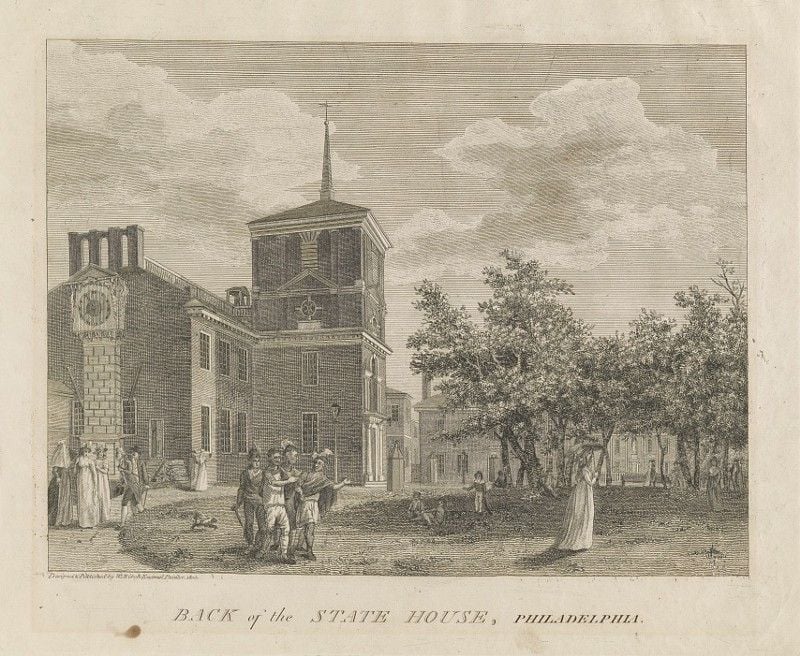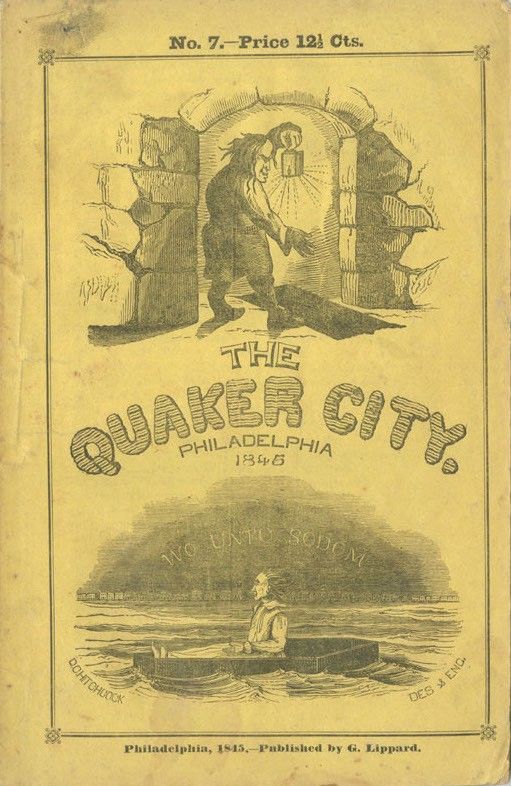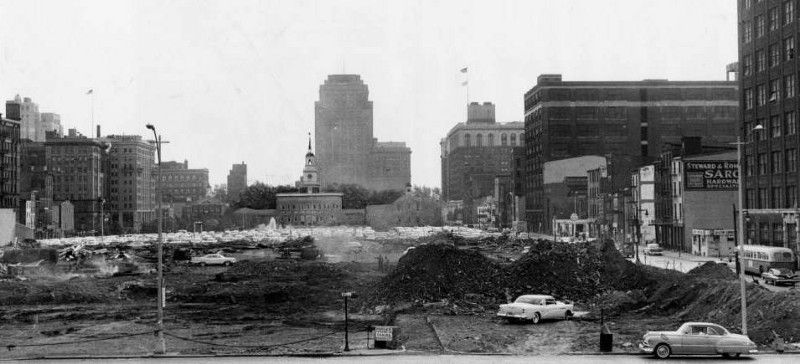Two Centuries Ago, Pennsylvania Almost Razed Independence Hall to Make Way for Private Development
Fortunately saner minds prevailed when the state thought about tearing down Philadelphia’s historic structure
/https://tf-cmsv2-smithsonianmag-media.s3.amazonaws.com/filer/d8/87/d88700e9-58b9-45f0-aaa7-d335a862a898/independence_hall_1752_map_detail.png)
Goodbye Independence Hall, hello Amazon headquarters! That was the “news” recently spoofed by the popular parody website, The Onion. The article lampooned Philadelphia’s eagerness to house Amazon’s second command center and included an image of the city leveled to make way for new business. “It was definitely bittersweet saying goodbye to the Liberty Bell,” says the satirical version of Mayor Jim Kenney, “but it’s important we encourage businesses to invest in the city.”
The article’s humor arises, in part, from treating one of the nation’s most cherished historic monuments as prime real estate. Yet 200 years ago, Philadelphians faced this very situation when the commonwealth of Pennsylvania planned to subdivide the site for private development. The resulting campaign to preserve Independence Hall featured the same critiques of urban development, capitalist greed, and corrupt public interest that appeared in The Onion two centuries later. Since then, observers have viewed Independence Hall as a bellwether of the values guiding urban development. Their commentary reminds us that citizens long have shaped historic sites not simply to commemorate the past but also to define what should not be for sale during times of economic transition.
Independence Hall’s preservation began in 1812 when Pennsylvania legislators planned to sell the building — then known as the old statehouse — and carve the surrounding green space into building lots. Colonial legislators had met in the building for four decades before American patriots made the spot notorious by signing the Declaration of Independence and debating the U. S. Constitution under its roof. After the state government removed its seat to Harrisburg in 1799, however, legislators saw the building and its surrounding land as potential revenue. Architectural salvage from the demolished building and multiple lots sold “to the highest and best bidders” would raise money to build a grand statehouse in the new capital.
Philadelphia’s municipal leaders valued the site in a different way. The age of the building and the grounds surrounding it, they argued, did not make the site ripe for development. The civic value of the place outweighed any financial profit that development would bring. In other words, permanence of this prime real estate would serve the public good.

The city government offered to buy the site from the commonwealth for $70,000. State legislators refused, insisting that they would not settle for less than $150,000. Thus began a five-year campaign to preserve the old statehouse and its grounds as city property. City councillors first challenged the legality of development. Since 1735, colonial legislation had mandated that none of the open space around the statehouse “be converted into or made use of for erecting any sort of building thereupon, but that the said ground shall be inclosed, and remain a publick open green and walk for ever.”[2]
Yet editorials and city council reports made arguments for the public good of open space and historic structures. They described the statehouse yard as a crucial source of air, light, and recreation for a growing urban populace. It also provided space for electioneering, they argued, which ensured the political health of the city and the nation. The historic features of the old statehouse contributed to civic health as well. They substantiated direct associations with the nation’s founding and formed an irreplaceable monument to a watershed moment in world history.
Philadelphia’s leaders argued that when commonwealth officials demanded the maximum market price, they betrayed the public interest they claimed to represent. The land’s market value had increased substantially in the speculative real estate economy of the early nineteenth century, and a handful of political elites stood to profit at the expense of Philadelphia’s residents. Market growth, city officials argued, did not always engender urban improvement.
Philadelphia’s City Council won out. In 1818, they took possession of the old statehouse and its yard. Their campaign for stewarding the site as permanent public space had helped to generate the political capital necessary to negotiate a sale on their terms. It also made Independence Hall a symbol for municipal leaders’ care for the city’s welfare.
Subsequent generations revived the threat of Independence Hall’s demolition as a means to criticize municipal leadership. In 1845, George Lippard wrote a popular novel, The Quaker City, that depicted Philadelphia’s municipal leaders as wealthy men who exploited women, impoverished workers, and public trust for their own gain. In Lippard’s dystopian narrative, these men replaced Independence Hall with a gilt palace and surrounded it with new buildings. As Philadelphia leaders remade the city to stimulate industry and commerce, Lippard used the demolition of Independence Hall to question who benefitted from these changes.

Municipal leaders, in turn, pointed to the preservation of Independence Hall as a sign of their public-mindedness. In the mid-20th century, urban planner Edmund Bacon introduced a plan to revitalize deindustrializing Philadelphia with attention to 18th-century architecture. He placed Independence Hall at the center of his plan to cultivate a tourist economy and leveled several blocks of 19th-century commercial buildings to open a dramatic vista of the building from Independence Mall. In this vision of preservation and redevelopment, Philadelphia could profit as a steward of national heritage. City leaders made the same argument when they advocated for Unesco World Heritage designation for the site in 1979 and the city in 2015.

When Onion writers depicted the mayor’s destruction of Independence Hall in 2017, they continued this conversation for a new generation facing economic and urban change. In recent weeks, Philadelphia’s municipal leaders have pulled out all the stops to pitch their city as the perfect locale for Amazon’s second headquarters. The “Philadelphia Delivers” campaign has spread glowing images of the city across a slick website and promotional video. It even bought advertising in the Seattle transit system. In this campaign, Philadelphia boosters highlight the city’s open space as a key feature of its appeal. Sites opened by the decline of industry — railyards by the Schuylkill River and South Philadelphia’s Navy Yard — await more productive uses in the new economy, they say.
Like the first writers who argued for the preservation of Independence Hall two hundred years ago, the Onion writers pushed back against the notion that old buildings and open space mark sites ripe for new development. The history of Independence Hall’s preservation shows how old this argument really is.
As Philadelphia faces a preservation crisis that could be intensified by the arrival of Amazon, Independence Hall recalls the city’s early commitment to the public protection of open space, historic buildings, and the sense of place defined by current city residents. Members of Mayor Kenney’s Historic Preservation Task Force, as well as all Philadelphians, would be wise to consider this legacy as they articulate a plan for managing the relationship between private development and civic health. Just as activists have used Independence Hall as a symbol for the expansion of civil rights, today’s city leaders might harness the ideals of public space embodied by this site to increase the number of sites that get preserved and the types of citizens involved in selecting them. In this way, Independence Hall can serve as an icon not only of the ideals of human equality but also of the city’s mandate to steward historic resources for all residents.
This article was originally published on Hindsights, the official blog of the Lepage Center for History in the Public Interest at Villanova University. Read more stories at medium.com/hindsights.